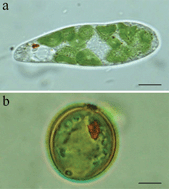Fundamental questions and concepts about photoreception and the case of Euglena gracilis
Abstract
The ability to sense light can be considered the most fundamental and presumably the most ancient property of visual systems. This ability is the basis of phototaxis, one of the most striking behavioral responses of motile photosynthetic microorganisms (i.e. microalgae) to light stimuli, which allows them to move toward or away directional light. In order to fully exploit the information content of light (intensity, direction, distribution) microorganisms need proper perceiving devices, termed photoreceptors, which must act as sensors, to perceive wavelength and direction of light, as transducers, to convert the light signal into chemical and/or electrical information, but also as amplifiers and eventually as transmitters. This review describes the universal structural, behavioral and physiological features necessary for the proper functioning of these devices in algae, and how these features have been investigated by means of different analytical techniques such as for example


 Please wait while we load your content...
Please wait while we load your content...